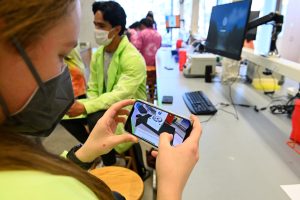
Johns Hopkins University undergraduate students who missed in-person lab work during the COVID-19 pandemic have created an augmented reality phone app to bring the laboratory to their smartphones.
The app, which has a video game feel to it, will help students build their confidence completing lab assignments. Beyond the pandemic, lower-income and international schools lacking lab equipment could use the app to ensure their students can access lab materials virtually.
Using the app, students can experience what it’s like to transfer liquids between test tubes, to analyze and separate DNA and protein molecules, or to operate a centrifuge. A haptics feature—simulating touch and motion—even allows users to feel what it’s like to hold these objects and move them around.
“We went to great lengths to make it hyper-realistic to help students understand what they’ll be working on,” said Chinat Yu, a junior computer science major at Johns Hopkins and project lead for the app.
Developed over the last two years by a team of about 20 students from the Bloomberg School of Public Health, Krieger School of Arts and Sciences, and Whiting School of Engineering, the app, called Quest2Learn, is now used by more than 100 students taking General Biology Laboratory I and the Biochemistry Project Lab.
“For me, the app is more helpful than reading pre-lab material or watching videos because it allowed me to mimic the hands-on experience you get from working in lab,” said Alejandro Garcia, a junior enrolled in the Biochemistry Project Lab. “Using the app is a different method of learning that has helped me gain more insight into the lab work.”
The developers envision students using the app even after the pandemic ends, so they’re developing more real-world labs for it: a spectrophotometry lab in which students will learn to use a nanodrop spectrophotometer to measure the absorbance of protein solutions, as well as an analytical lab that will teach students how to use an analytical balance to measure the weight of substances and create a solution.
The development team is in discussions with the Chinese University of Hong Kong and Baltimore-area high schools about incorporating the app into their lab science curriculums.
“None of us envisioned the app being used in classes when we first started this journey of developing it, so it feels like a dream to see where the app is now,” said Siddharth Ananth, a junior computer science major at Johns Hopkins and technology lead for the app.